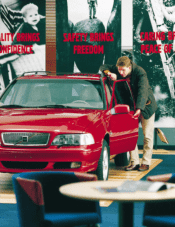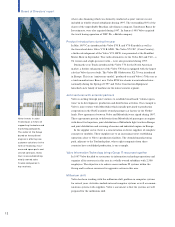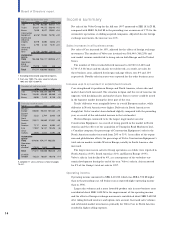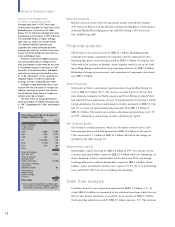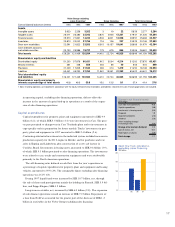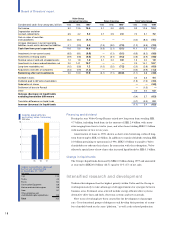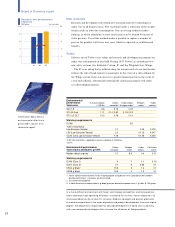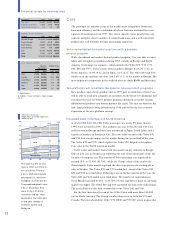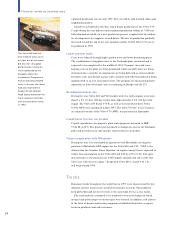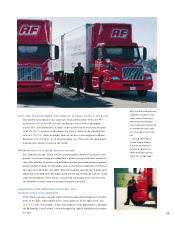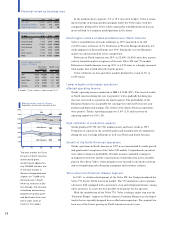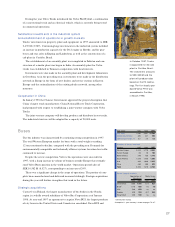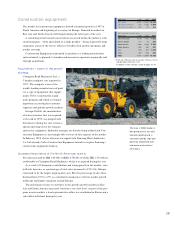Volvo 1997 Annual Report Download - page 21
Download and view the complete annual report
Please find page 21 of the 1997 Volvo annual report below. You can navigate through the pages in the report by either clicking on the pages listed below, or by using the keyword search tool below to find specific information within the annual report.
19
process. Global development of heavy trucks is taking place in Trucks based on
a similar platform concept.
Buses is assuming ever-greater responsibility for the development of complete
products by integrating manufacturers of bodies and producers of complete
buses. Volvo Penta has broadened its operations by designing diesel/electric drive
lines for ships and trains. The “Ecoship,” with propulsion of this type, was intro-
duced during 1997. Programs under way within the Aero business area involve
the use of information technology to control manufacturing and maintenance
processes, to regulate jet engines by means of directional nozzles in order to
increase turning performance, and to develop small gas turbines for propulsion
and electric power production.
Energy-efficient drive systems and lower emissions
Volvo has undertaken to reduce the fuel consumption of its passenger cars that
are sold within the European Union by 25% during the 1990-2005 period. This
would mean an average consumption of 6.8 liters per 100 km in the year 2005.
The greater part of the fuel reduction is to be achieved through engine-technol-
ogy measures such as reduced friction and the introduction of technology for
direct fuel injection. Beginning in 1998, Volvo will gradually introduce cars with
direct fuel injection. This technology is expected to reduce fuel consumption by
between 10% and 15%.
Products based on diesel engines for heavy vehicles account for approximately
45% of the Volvo Group’s net sales. In consultation with the affected business
areas, diesel engines are being developed to meet the varying demands of the
different application areas. Volvo is also working to further increase fuel efficiency
and to reduce emissions from heavy vehicles, through improved technology and
more effective control of the combustion process, among other measures. New,
stricter emission standards which are expected to become effective for trucks and
buses in 2004 result in a technological generation shift for heavy diesel engines.
Development of the new generation of diesel engines is fully under way and the
new engines will be introduced successively, beginning in 2001.
The development of vehicles with alternative drive lines (hybrid vehicles) and
fuels will be intensified as a step toward reducing fuel consumption and exhaust
emissions. Sales of the Volvo S70 and V70 Bi-Fuel models, which can be opera-
ted with both gasoline and methane gas, and meet the California ULEV require-
ments, amounted to 350 units in 1997. In addition to Sweden, these cars are
being sold in a number of markets in Europe and in Japan. Volvo’s buses that are
fueled by natural gas are being sold in a growing number of markets, and trucks
fueled by natural gas are being field-tested by customers. A Volvo FL6 electric
hybrid truck with a diesel engine and an electric engine, designed for use in dis-
tribution systems in densely populated areas, was presented in 1997.
Electronic system s
Volvo is also allocating substantial resources to develop cars’ electric systems
and the use of information technology, including navigation systems such as
“Dynafleet” and “Dynaguide.” Volvo is sponsoring long-term projects in this
field, including a project known as “Things That Think” at Massachusetts
Institute of Technology. Among other things, the project involves “smart cars”
that help drivers avoid making mistakes.
Lower fuel consum ption is a
priority environm ental issue
in Volvo
Lower fuel consum ption in new
vehicles and engines is a priority
issue in research and development
for Volvo. In Decem ber 1997, Volvo
established the objective that each
new concept vehicle should be more
fuel efficient than the product it is
replacing. In the case of passenger
cars sold within the EU, Volvo’s
objective is to reduce fuel consum p-
tion by 25% by the year 2005, com -
pared with 1990.
Volvo’s goal is to integrate en-
vironm ental efforts into daily opera-
tions at all levels and the local op-
erative responsibility is delegated
to local supervisors. Environmental
control system s based on internatio-
nal standards and recommendations
are gradually being introduced in
Volvo. The purpose is to reduce
environmental risk s, achieve cost
savings, and to clarify objectives
and the m anner in which they are
being m et.
Environm ental audits provide a
solid foundation when environmen-
tal control system s are being intro-
duced. Eighty-two environmental
audits, including 25 in 1997, have
been conducted since 1989. During
1998, environm ental audits of an
additional 18 facilities are planned.
There is no reason to believe that
these audits will reveal that the
facilities present any significant
environmental risk .
Volvo’s goal is also to recycle
85% of the vehicles’ weight by 2002
and 95% by 2015. This will be accom -
plished by designing for recycling
and establishing a network for auto-
motive recycling in various markets.
Environm ental data pertaining to
the production process is presented
in tabular form on page 87


